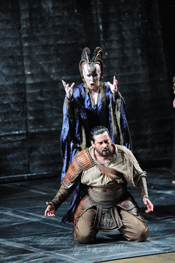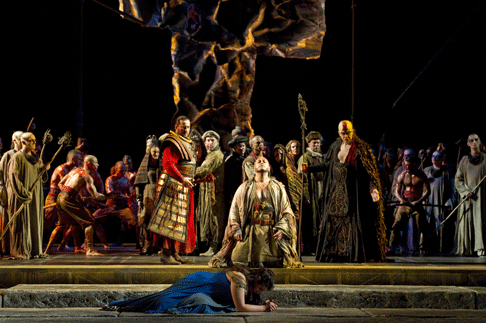02 May 2010
No Elephants — Aida at the Royal Opera House, London
It’s time Verdi got attention in Aida, not elephants.

It’s time Verdi got attention in Aida, not elephants.
The blue elephant in Graham Vick’sTamerlano almost stole the show, but elephants were pointedly banned from this new production of Aida at the Royal Opera House, London. Instead, Verdi’s music takes pride of place, revealed in full glory.
Pre-performance publicity indicated that this would not be a stereotype production, but minimalist it certainly was not. Abstraction in many ways suits Aida, an opera of secrets and mysteries.
 Marcelo Álvarez as Radames and Marianne Cornetti as Amneris
Marcelo Álvarez as Radames and Marianne Cornetti as Amneris
Large structures loom over the cast, for this is a drama where individuals are pitted against overwhelming forces. The simple, strong lines also permit a new kind of staging, created from light and colour.
No elephants, no circus. Instead the focus shifts onto Verdi’s music itself, revealing its magnificence without distraction. How glorious it is, heard as music! Indeed, it’s because Aida is so vivid orchestrally that we’ve become accustomed to associating it with grand panoramas. But music is in itself abstract. This time, the orchestral colours can be seen as well as heard. Shades of rose and ochre, scarab and peacock, amethyst and sand, glow iridescently, transforming as the music develops. Synaesthetes may overload, but this abstraction is surprisingly expressive, given the connection between visual image and music.
Nicola Luisotti conducted with flair..Tempi were on the fast side, but better that than too slow. Freed from the restraints of cumbersome staging, the orchestra’s pace matched the nervous energy in the drama. Violent moods, violent music. In the scene at the Temple of Vulcan, the Egyptians are working themselves up to a frenzy. Heightened emotion in the orchestra but less so in the dancing. The Rite of Spring style choreography would not have been out of place, but perhaps too much to expect. Strange, distorted shapes hang from the sky, like the corpses of the dead. When the prisoners shuffle in, they look like they’ve been in battle. As Aida (Micaela Carosi) reminds us, the Triumphal March may be triumph for some, but defeat for others.
In the third act, when Aida sings “Qui Radamès verrà,|” Carosi stands before a black and white panel, as stark as the dilemma before her. But when Micaela Carosi sings, the lusciousness of her music translates into washes of blue and green, evoking the dark, swift Nile and “cieli azzurri” above, her Egyptian present and memories of her native land. Carosi is a very experienced Aida. Her middle voice is secure, so the extremes in the part feel natural, rather than over-coloured. Aida is constrained, all around, by secrecy and the need for stealth, so she is a strong personality, and alert.

Marcelo Álvarez as Radames is a more conventional portrayal. He hectors, but then, Radames is a headstrong hero, eager for battle, but ennobled by the grace of love. His finest moment comes as he and Aida face death, when his voice softens and takes on a gentler tone. Marianne Cornetti was a forceful, forthright Amneris, and Marco Vratogna’s Amonasro suitably subdued.
Jennifer Tipton deserves much credit for designing the magnificent light show. David McVicar proves that abstraction does not mean minimal, and is just as valid musically as circus gimmicks.
Anne Ozorio